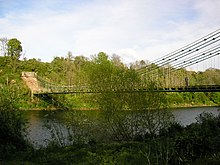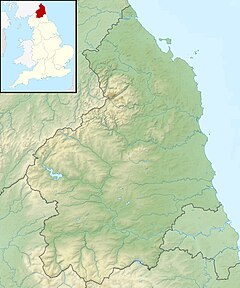Union Bridge (Tweed)
| Union Bridge | |
|---|---|
 |
|
| Coordinates | 55°45′09″N 2°06′25″W / 55.7525°N 2.107°WCoordinates: 55°45′09″N 2°06′25″W / 55.7525°N 2.107°W |
| Crosses | River Tweed |
| Characteristics | |
| Number of spans | 1 |
| History | |
| Designer | Captain Samuel Brown |
| Construction begin | 1819 |
| Opened | 26 July 1820 |
The Union Bridge, also known as the Union Suspension Bridge or Union Chain Bridge, is a suspension bridge that spans the River Tweed between Horncliffe, Northumberland, England and Fishwick, Berwickshire, Scotland. In so doing it also spans the border between England and Scotland. When it opened in 1820 it was the longest wrought iron suspension bridge in the world with a span of 137 metres (449 ft), and the first vehicular bridge of its type in United Kingdom.
Although work started on the Menai Suspension Bridge first, the Union Bridge was completed earlier. Today it is the oldest suspension bridge still carrying road traffic. It lies on Sustrans Route 1 and the Pennine Cycleway.
Before the opening of the Union Bridge, crossing the river at this point involved an 11-mile (18 km) round trip via Berwick-upon-Tweed downstream or a 20-mile (32 km) trip via Coldstream upstream. (Ladykirk and Norham Bridge did not open until 1888.)
The bridge was designed by an English Royal Navy officer, Captain Samuel Brown. Brown joined the Navy in 1795, and seeing the need for an improvement on the hemp ropes used, which frequently failed with resulting loss to shipping, he employed blacksmiths to create experimental wrought iron chains. The HMS Penelope was fitted with iron rigging in 1806, and in a test voyage proved successful enough that in 1808, with his cousin Samuel Lenox, he set up a company that would become Brown Lenox & Co. Brown left the Navy in 1812, and in 1813 he built a prototype suspension bridge of 105 feet (32 m) span, using 296 stone (1,880 kg) of iron. It was sufficiently strong to support a carriage, and John Rennie and Thomas Telford reported favourably upon it.
...
Wikipedia

